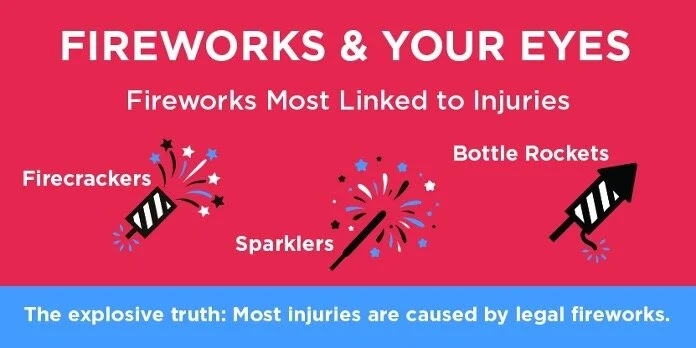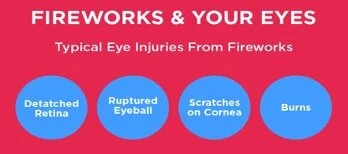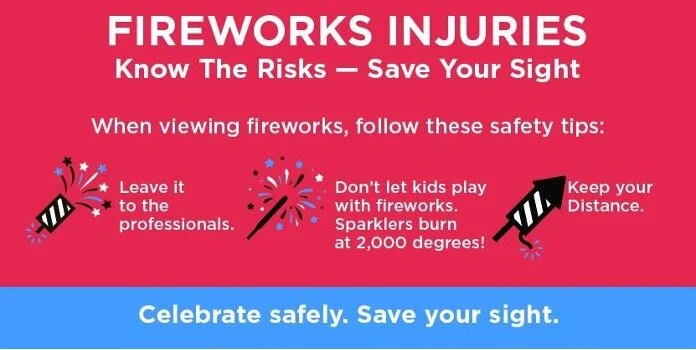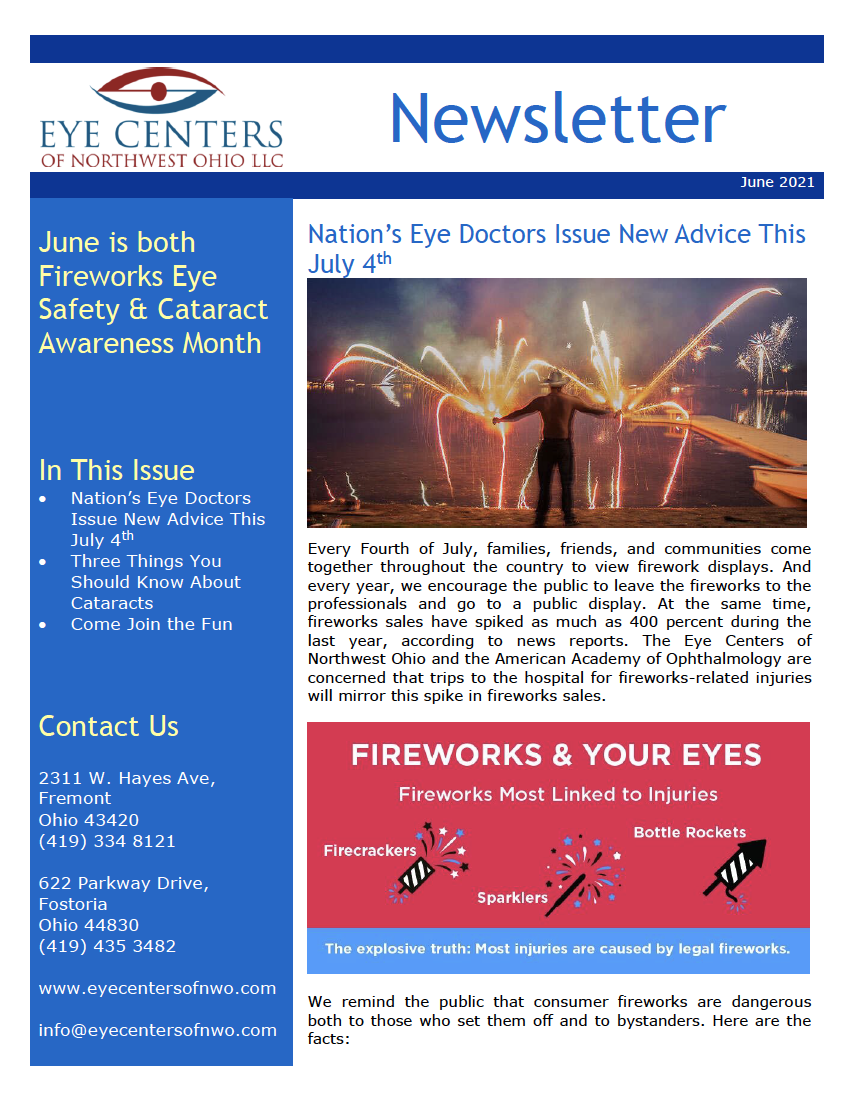June 2021 Newsletter
Nation’s Eye Doctors Issue New Advice This July 4th
Every Fourth of July, families, friends, and communities come together throughout the country to view firework displays. And every year, we encourage the public to leave the fireworks to the professionals and go to a public display. At the same time, fireworks sales have spiked as much as 400 percent during the last year, according to news reports. The Eye Centers of Northwest Ohio and the American Academy of Ophthalmology are concerned that trips to the hospital for fireworks-related injuries will mirror this spike in fireworks sales.
We remind the public that consumer fireworks are dangerous both to those who set them off and to bystanders. Here are the facts:
The US Consumer Product Safety Commission reported 10,000 injuries and 12 firework-related deaths in 2019.
A 2017 study showed that 65 percent of people injured by fireworks are bystanders.
An April 2020 study in JAMA Ophthalmology showed that an estimated 34,548 firework-related eye injuries occurred between 1999 and 2017, with approximately 65 percent occurring in children. The most common injuries were ocular burns, ocular foreign body, and conjunctival irritation. Most injuries occurred at home (75 percent) with consumer use of fireworks during the 4th of July. Although all types of consumer fireworks are dangerous, bottle rockets caused the most severe injuries, such as ruptured globes.
Here’s how to make sure your backyard celebration doesn’t end in the ER:
Don't pick up duds and misfires: Fireworks nearly cost an Ohio firefighter his sight. He took all the right precautions for his backyard Fourth of July fireworks celebration. But a split-second decision to inspect a "dud" was almost fatal.
Supervise children closely: Sparklers seem like harmless fun for the kids, but they are responsible for about 1,400 eye injuries each year. Even those tiny poppers or snappers can pose dangers.
Wear protective eyewear: Ophthalmologists recommend American National Standards Institute (ANSI)-approved protective eyewear. Stop by any hardware store and pick up some safety glasses for the entire family.
If you suffer an eye injury from a firework:
Seek medical attention immediately.
Do not rub, rinse or apply pressure to your eyes.
Do not remove any objects that are stuck in the eye.
Three Things You Should Know About Cataracts
Approximately 25 million Americans have cataracts, which causes cloudy, blurry or dim vision and often develops with advancing age. This June, the Eye Centers of Northwest Ohio joins the American Academy of Ophthalmology in observing Cataract Awareness Month by sharing three things everyone should know about the condition and its treatment.
As everyone grows older, the lenses of their eyes thicken and become cloudier. Eventually, they may find it more difficult to read street signs. Colors may seem dull. These symptoms may signal cataracts, which affect about 70 percent of people by age 75. Fortunately, cataracts can be corrected with surgery. Ophthalmologists, physicians who specialize in medical and surgical eye care, perform around three million cataract surgeries each year to restore vision to those patients. The following are facts people should know about the condition.
Age isn’t the only risk factor for cataracts. Though most everyone will develop cataracts with age, recent studies show that lifestyle and behavior can influence when and how severely you develop cataracts. Diabetes, extensive exposure to sunlight, smoking, obesity, high blood pressure and certain ethnicities have all been linked to increased risk of cataracts. Eye injuries, prior eye surgery and long-term use of steroid medication can also result in cataracts. If you have any of these or other risk factors, talk to your eye doctor.
Cataracts cannot be prevented, but you can lower your risk. Wearing UV-blocking sunglasses and brimmed hats when outside can help. Several studies suggest that eating more vitamin C-rich foods may delay how fast cataracts form. Also, avoid smoking cigarettes, which have been shown to increase the risk of cataract development.
Surgery may help improve more than just your vision. During the procedure, the natural clouded lens is replaced with an artificial lens called an intraocular lens, which should improve your vision significantly. Patients have a variety of lenses to choose from, each with different benefits. Studies have shown that cataract surgery can improve quality of life and reduce the risk of falling.
For further information on cataract surgery, visit our website at https://www.eyecentersofnwo.com/cataract-surgery
Come Join the Fun!
All profits from hot dogs and refreshments will go to Pilot Dogs in Columbus. For more information on Pilot Dogs, visit their website at https://www.pilotdogs.org/
June is both Fireworks Eye Safety & Cataract Awareness Month
In This Issue
Nation’s Eye Doctors Issue New Advice This July 4th
Three Things You Should Know About Cataracts
Come Join the Fun
Contact Us
2311 W. Hayes Ave,
Fremont
Ohio 43420
(419) 334 8121
622 Parkway Drive,
Fostoria
Ohio 44830
(419) 435 3482
Courtesy: Prevent Blindness
Courtesy: National Eye Institute, National Institutes of Health (NEI/NIH)
No Vision Insurance, No Problem. Join our Membership Program today!
Courtesy: The American Academy of Ophthalmology
For previous newsletters:








